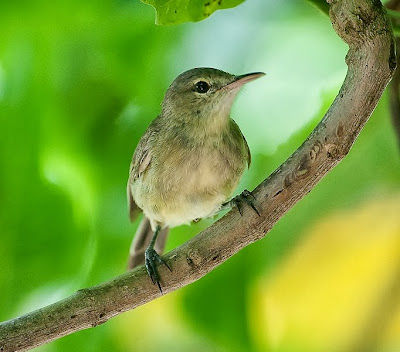Acrocephalus sechellensis
 |
| Photo by Terje Kolaas (Flickr) |
Common name:
Seychelles warbler (en); felosa-das-Seychelles (pt); rousserolle des Seychelles (fr); carricero de Seychelles (es); Seychellen-rohrsänger (de)
Taxonomy:
Order Passeriformes
Family Sylviidae
Range:
This species is endemic to the Seychelles archipelago. At present they are only found in the islands of Cousin, Aride, Cousine and Denis.
Size:
These birds are 14 cm long and weigh 15-17 g.
Habitat:
The Seychelles warbler is found in most tropical scrublands with large Pisonia grandis and Ficus reflexa trees.
Diet:
They feed on a variety of insects, including bugs and their eggs, beetles, bees and ants, but also spiders and, occasionally, small skins and geckos.
Breeding:
The Seychelles warbler is monogamous and mates for life. They have a cooperative breeding system, with helpers, usually the daughters from previous broods, helping defend the territory, build the nest, incubate the eggs and feed the young. They breed in June February. The female lays a single egg, which is incubated for 15 days. The chick fledges 14 days after hatching but may continue to receive food from the parents and helpers for several months.
Conservation:
IUCN status - VU (Vulnerable)
This species was an extremely small breeding range and a global population estimated at 1.700 individuals. The Seychelles warbler was originally found in several islands in the Seychelles, but human disturbance, habitat destruction and predation by introduced predator lead them to disappear in all islands except Cousin. Even in that island, the population reach an all time low of less than 30 individuals in the 1960s, but has since recovered thanks to
favourable management and conservation policies. In Cousin, management included the regeneration of Pisonia woodlands, and cessation of intensive management of coconut Cocos nucifera plantations. The islands of Aride, Denis and Cousine were also the target of habitat management and predator control, and have been populated successfully with birds from Cousin. These conservation efforts and considerable population recovery make the Seychelles warbler a great success case for nature conservation.
No comments:
Post a Comment